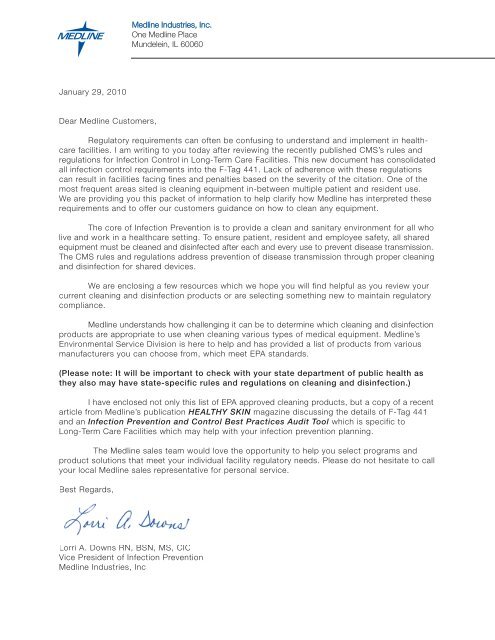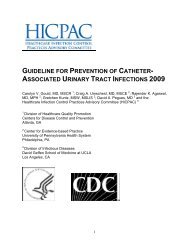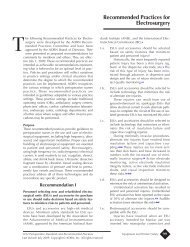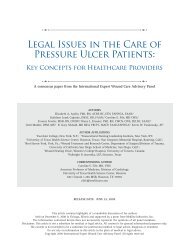Tag F-441 Compliance Aid - Medline
Tag F-441 Compliance Aid - Medline
Tag F-441 Compliance Aid - Medline
- No tags were found...
Create successful ePaper yourself
Turn your PDF publications into a flip-book with our unique Google optimized e-Paper software.
<strong>Medline</strong> Industries, Inc.One <strong>Medline</strong> PlaceMundelein, IL 60060January 29, 2010Dear <strong>Medline</strong> Customers,Regulatory requirements can often be confusing to understand and implement in healthcarefacilities. I am writing to you today after reviewing the recently published CMS’s rules andregulations for Infection Control in Long-Term Care Facilities. This new document has consolidatedall infection control requirements into the F-<strong>Tag</strong> <strong>441</strong>. Lack of adherence with these regulationscan result in facilities facing fines and penalties based on the severity of the citation. One of themost frequent areas sited is cleaning equipment in-between multiple patient and resident use.We are providing you this packet of information to help clarify how <strong>Medline</strong> has interpreted theserequirements and to offer our customers guidance on how to clean any equipment.The core of Infection Prevention is to provide a clean and sanitary environment for all wholive and work in a healthcare setting. To ensure patient, resident and employee safety, all sharedequipment must be cleaned and disinfected after each and every use to prevent disease transmission.The CMS rules and regulations address prevention of disease transmission through proper cleaningand disinfection for shared devices.We are enclosing a few resources which we hope you will find helpful as you review yourcurrent cleaning and disinfection products or are selecting something new to maintain regulatorycompliance.<strong>Medline</strong> understands how challenging it can be to determine which cleaning and disinfectionproducts are appropriate to use when cleaning various types of medical equipment. <strong>Medline</strong>’sEnvironmental Service Division is here to help and has provided a list of products from variousmanufacturers you can choose from, which meet EPA standards.(Please note: It will be important to check with your state department of public health asthey also may have state-specific rules and regulations on cleaning and disinfection.)I have enclosed not only this list of EPA approved cleaning products, but a copy of a recentarticle from <strong>Medline</strong>’s publication HEALTHY SKIN magazine discussing the details of F-<strong>Tag</strong> <strong>441</strong>and an Infection Prevention and Control Best Practices Audit Tool which is specific toLong-Term Care Facilities which may help with your infection prevention planning.The <strong>Medline</strong> sales team would love the opportunity to help you select programs andproduct solutions that meet your individual facility regulatory needs. Please do not hesitate to callyour local <strong>Medline</strong> sales representative for personal service.Best Regards,Lorri A. Downs RN, BSN, MS, CICVice President of Infection Prevention<strong>Medline</strong> Industries, Inc
Small Equipment DisinfectionTAG F<strong>441</strong> COMPLIANCE AIDResident-care devices (e.g., electronic thermometers or glucose monitoring devices)may transmit pathogens if devices contaminated with blood or body fluids are sharedwithout cleaning and disinfecting between uses for different residents.Reducing and/or preventing infections through indirect contact requires thedecontamination (i.e., cleaning, sanitizing, or disinfecting an object to render it safefor handling) of resident equipment, medical devices, and the environment.<strong>Medline</strong> offers three proven solutions for disinfection. All meet CMS/CDC/OSHAguidelines for 1:10 bleach solution (equivalent to 0.5 to 0.6% sodium hypochlorite)for clinical effectiveness. All products below are registered with the EPA.Dispatch ® hospital cleaner towels with bleach save you from mixingyour own 1:10 bleach dilution daily (as OSHA recommends). Anindividually wrapped towel or one from the 60-count soft pack will“wet cover” about 10 square feet for a one-minute count.The 150-count pop-up towel will cover about 18 square feet.CLH69150 Canister, 150/can, 8 can/csCLH69260 Soft Pack 60/pk, 12 pk/csCLH69101 Individually Wrapped 50/bx, 6 bx/csClorox ® , long the standard in one-step disinfecting, produces hospitalgradewipes with a 0.55% sodium hypochlorite disinfectant. Packedin a 70-count pop-up tub, the wipes are heavier and stronger thanmost on the market. Tested for compliance with safety, efficacy, shelflife and label strength standards.CLO35309 Canister 70/can, 6 can/csGluco-Chlor ® is designed specifically for disinfecting glucose metersand other bedside test equipment. 3” x 3” lint free wipes arenon-abrasive and compatible with delicate optical components.Super-Chlor ® wipes use the same 0.525% ClNaO solution in alarger wipe (9” x 9” or 12” x 12”) for larger surfaces.MOIGC110 Gluco-Chlor Wipe 3"x3" 100 pk/bx, 12 bx/csMOIGC110Z Gluco-Chlor Wipe 3"x3" 100 pk/bxMOISC110 Super-Chlor Wipe 9"x9" 100 pk/bx, 8 bx/csMOIGC112 Super-Chlor Wipe 12"x12" 50 pk/bx, 8 bx/cs<strong>Compliance</strong> aid is one phone call away. Order your disinfection wipes from <strong>Medline</strong> today.1-800-MEDLINE or medline.com.<strong>Medline</strong> is a registered trademark of <strong>Medline</strong> Industries, Inc. Dispatch is a registered trademark of Caltech Industries, Inc.Clorox is a registered trademark of The Clorox Company. Gluco-Chlor and Super-Chlor are registered trademarks of Medtrol, Inc.
Focus onInfectionControlUnderstanding the New F-<strong>Tag</strong> <strong>441</strong> RequirementsIf you’re confused about the Centers for Medicare & Medicaid Services(CMS) revised F-<strong>Tag</strong> <strong>441</strong> requirements regarding shared medical devices –particularly glucose meters – you’re not alone.Although every infection preventionist, healthcare worker, administrator andregulatory surveyor certainly would prefer long-term care facilities to providededicated medical equipment for each resident, they also realize this can becost prohibitive. Therefore, CMS and the CDC guidelines allow for thesharing of durable medical equipment – such as glucose meters – as longas it is properly cleaned and disinfected between every patient use.By Lorri A. Downs, RN, BSN, MS, CIC,Vice President of Infection PreventionWhy are the regulatory eyes of CMS looking so closelyat cleaning and disinfection?Healthcare-associated infections are a major concern, andgerms are commonly transmitted from person to person viamedical devices. The new F-<strong>Tag</strong> <strong>441</strong> states: 1“Infections are a significant source of morbidity andmortality for nursing home residents and account for up tohalf of all nursing home resident transfers to hospitals.Infections result in an estimated 150,000 to 200,000hospital admissions per year at an estimated cost of $673million to $2 billion annually. When a nursing home residentis hospitalized with a primary diagnosis of infection, the deathrate can reach as high as 40 percent. It is estimated that anaverage of 1.6 to 3.8 infections per resident occur annuallyin nursing homes.”Reducing and/or preventing infections acquired throughindirect contact with surfaces or medical equipment requiresdecontamination (cleaning, sanitizing or disinfection) prior toexposing a different resident to the particular piece ofmedical equipment.When devices are shared, staff training and education iscrucial to ensure proper infection control. One commonbarrier is lack of clear delegation of equipment cleaning tasks.If the responsibility is left to everyone, often no one ends upperforming the cleaning task. Healthcare workers are busyand simply assume another staff member completed thissimple but critical task.How has F-<strong>Tag</strong> <strong>441</strong> changed?As mentioned earlier, CMS is especially concerned aboutinfection control due to the rising rates of healthcare-acquiredconditions. They have combined all F-<strong>Tag</strong>s related toinfection control (i.e., F-<strong>Tag</strong> <strong>441</strong>, 442, 443, 444 and 445) intoone location under F-<strong>Tag</strong> <strong>441</strong> to make these guidelines moreaccessible. F-<strong>Tag</strong> <strong>441</strong> is now the “one-stop-shop” forinfection control requirements.The revisions to F-<strong>Tag</strong> <strong>441</strong> are based in part on a Centers forDisease Control and Prevention (CDC) report describingseparate outbreaks of hepatitis B virus (HBV) linked to thesharing of blood glucose monitoring equipment at long-termcare facilities in Mississippi, North Carolina and California. 2Investigators suggest that recommendations concerningstandard precautions and the reuse of fingerstick deviceshave not been adhered to or enforced consistently inlong-term care settings. The potential for devices to carrybloodborne pathogens and multidrug resistant bacteria andviruses (if the device is not cleaned between every use) iswell-documented in the CDC report. For a copy of thereport, go to www.cdc.gov/mmwr/preview/mmwrhtml/mm5409a2.htm. Ultimately the safety of your residents andemployees is at the core of most of the rules and regulationssurrounding infection control. Yet it can be challenging tokeep up with all the regulatory changes. Implementingroutine processes will increase your staff’s knowledge andawareness, along with the assurance that clean care really issafer care.How will this regulatory change affect long-term carefacilities?Regulatory inspections will be more frequent, and facilitiesthat are 1.) cited with severe non-compliance with the new
F-<strong>Tag</strong> <strong>441</strong> requirements and 2.) fail to implement preventativeor corrective measures will no longer be able to participate inMedicare – a financially devastating prospect.Non-compliance is categorized into the following levelsaccording to severity. Note that not cleaning glucose metersbetween residents falls under the most severe level ofnon-compliance.New CMS Infection ControlRequirements for Long-TermCare FacilitiesSeverity Level 4 – Immediate jeopardy to resident healthor safety: Non-compliance with one or more requirementshas caused or is likely to cause serious harm, impairment ordeath to a resident.Example:“The facility failed to follow standard precautions during theperformance of routine testing of blood sugars. The facilitydid not clean and disinfect the glucometers before or afteruse and did not use new glucometer lancets on residentswho required blood sugar monitoring. This practice of notcleaning and disinfecting glucometers between every useand re-using glucometer lancets created an ImmediateJeopardy to resident health by potentially exposing residentsto the spread of blood borne infections for multiple residentsin the facility who required blood sugar testing.” 1Listed below are the infection control requirementsunder F-<strong>Tag</strong> <strong>441</strong> that long-term care facilities mustfollow in order to be Medicare providers and receivereimbursement from CMS. 1“The intent of this regulation is to assure that thefacility develops, implements, and maintains anInfection Prevention and Control Program in order toprevent, recognize, and control, to the extentpossible, the onset and spread of infection within thefacility. The program will:Perform surveillance and investigation to prevent,to the extent possible, the onset and the spreadof infection.Ten Tips forCleaning andDisinfectingShared MedicalEquipmentSeverity Level 3 – Actual harm that is not immediatejeopardy: The negative outcome can include, but may notbe limited to clinical compromise, decline or the residentsinability to maintain and/or reach his or her highestpracticable well-being.Example:“The facility routinely sent urine cultures of asymptomaticresidents with indwelling catheters, putting residents withpositive cultures on antibiotics, resulting in two residentsacquiring antibiotic-related colitis and significant weight loss.” 1Severity Level 2 – No actual harm with potential for morethan minimal harm that is not immediate jeopardy:Non-compliance that results in a resident outcome of no morethan minimal discomfort and/or has the potential to compromisethe resident’s ability to maintain or reach his or her highestpracticable level of well being. The potential exists forgreater harm to occur if interventions are not provided.Example:“The facility failed to ensure that their staff demonstratesproper hand hygiene between residents to prevent thespread of infections. The staff administered medications to aresident via a gastric tube and while wearing the same glovesproceeded to administer oral medications to anotherresident. The staff did not remove the used gloves and washor sanitize their hands between residents.” 1Prevent and control outbreaks and crosscontaminationusing isolation precautions inaddition to standard precautions.Use records of infection incidents to improve itsinfection control processes and outcomes bytaking corrective actions, as indicated.Implement hand hygiene practices consistentwith accepted standards of practice, to reducethe spread of infections and prevent crosscontamination.Properly store, handle, process, and transportlinens to minimize contamination.”References1. CMS Manual. Interpretive Guidelines for Long-Term Care Facilities <strong>Tag</strong>F<strong>441</strong>. Available at: http://www.cms.hhs.gov/transmittals/downloads/R55SOMA.pdf. Accessed January 21, 2010.2. Centers for Disease Control and Prevention. Transmission of hepatitis Bvirus among persons undergoing blood glucose monitoring in long-termcare facilities: Mississippi, North Carolina and Los Angeles County,California, 2003-2004. MMWR 2005;54(09): 220-223. Available at:http://www.cdc.gov/mmwr/preview/mmwrhtml/mm5409a2.htm.Accessed January 21, 2010.1 Make a list of every piece of shared medical equipment.(Assign clinical staff to help identify and generate theequipment list.)2 Assign the cleaning and disinfection responsibility to thetype of healthcare worker who will be performing the taskwithin your policy.3 Communicate this administrative decision to all membersof your staff, both written and verbally, and document.4 Educate and train staff on proper care, maintenance, cleaningand storage of each piece of equipment. At a minimum, providethis education upon initial employment, when the equipment isreplaced with a newer model and annually. Document that thistraining has occurred.5 Select easy-to-use, EPA-registered hospital gradedisinfectants and cleaning products. Make sure the productslist which microorganisms and viruses it kills. Commoncleaners are sodium hypochlorite (bleach solution) or quaternaryammonium products. However, to help avoid warranty issuesor equipment damage, be sure to follow manufacturers’recommendations regarding which cleaning products to use.6 Clean medical device surfaces when visible blood or bloodyfluids are present by wiping with a cloth dampened withsoap and water to remove any visible organic material, andthen disinfect.7 If no visible organic material is present, disinfect the exteriorsurfaces after each use using a cloth or wipe with either anEPA-registered detergent/germicide with a turberculocidal orHBV/HIV label claim, or a dilute bleach solution of 1:10 to 1:100concentration.8 Never use alcohol to clean medical equipment such asglucose meters because it can damage the light emitting diodes(LED) readouts, causing fogging of plastic screens. Alcohol alsois not an EPA-registered detergent/disinfectant.9 Disposable professional grade wipes with a short “kill time”(60 seconds after application) can make the time spent cleaningequipment quick and easy. Limit the different types of wipesused at your facility to one or two. The more products you use,the more likely employees will become confused.10 All cleaning should be done in well-ventilated areas withgloves to protect healthcare workers’ hands.
INFECTION PREVENTION AND CONTROL BEST PRACTICESFOR LONG TERM CARE AND COMMUNITY CARE INCLUDING HEALTH CARE OFFICES AND AMBULATORY CLINICSAPPENDIX III – AUDIT TOOL (A)LONG TERM CARE AUDITAUDIT PERFORMED BY __________________________ DATE:___________________AREA AUDITED :_______________________________AREAS AND ITEMSCOMMENTSFULLYIMPLEMENTEDPARTLYIMPLEMENTEDNOTIMPLEMENTEDN/AENTRY TO FACILITYInfection Control Signage at Entry (related toscreening for communicable diseases)Hand Hygiene Station at entranceUNIT LEVELClient assessed before entry for risk factors (fever,cough, diarrhea, rash, drainage)Written policy and procedure for client assessmentIncludes: drainage, cough, fever, continence, ability tofollow hygiene measuresProtective equipment availableGlovesMasksGownsAlcohol-based hand rub stationsGoggles/eye protectionCleaner for client equipmentWritten Policies for Dress Code:Includes no jewellery (rings or bracelets)No nail enhancementsSource: Canadian Committee on Antibiotic Resistance (2007) Infection Prevention and Control Best Practices for Long TermCare, Home and Community Care including Health Care Offices and Ambulatory Clinics
INFECTION PREVENTION AND CONTROL BEST PRACTICESFOR LONG TERM CARE AND COMMUNITY CARE INCLUDING HEALTH CARE OFFICES AND AMBULATORY CLINICSAPPENDIX III – AUDIT TOOL (A)LONG TERM CARE AUDIT (CONTINUED)AREAS AND ITEMSCOMMENTSFULLYIMPLEMENTEDPARTLYIMPLEMENTEDNOTIMPLEMENTEDN/ASignage for hand washingSignage for alcohol-based hand rubSigns showing how to wash handsSigns showing How to use alcohol-based hand rubStaff can identify when to use hand hygiene:Before resident careBefore aseptic practicesAfter resident careAfter contact with body fluids or mucousmembranesAfter contact with contaminated equipmentResident equipment has regular cleaning scheduleCommodesBP CuffsSlingsGlucometersCleaners used are appropriate and used according tomanufacturer’s recommendationsconcentration contact timeClean procedures use sterile suppliese.g. Wound careCatheterizationResident Personal Care Equipment is labeledand stored safelySource: Canadian Committee on Antibiotic Resistance (2007) Infection Prevention and Control Best Practices for Long TermCare, Home and Community Care including Health Care Offices and Ambulatory Clinics
INFECTION PREVENTION AND CONTROL BEST PRACTICESFOR LONG TERM CARE AND COMMUNITY CARE INCLUDING HEALTH CARE OFFICES AND AMBULATORY CLINICSAPPENDIX III – AUDIT TOOL (A)LONG TERM CARE AUDIT (CONTINUED)AREAS AND ITEMSCOMMENTSFULLYIMPLEMENTEDPARTLYIMPLEMENTEDNOTIMPLEMENTEDN/ALAUNDRYLaundry is transported in a clean mannerSoiled laundry in sealed bagsClean in segregated mannerLaundry is sorted by staff wearing PPEHand hygiene is available in laundry areaEducation is provided to laundry workers onprotective practiceImmunization is offered to laundry workers forHepatitis BWASTEPuncture Resistant Sharps containers are usedWritten policies reflect waste segregationSharps containers not more than 3/4 filledSharps containers are accessible and safeHEALTHY WORKPLACEDocumentation of staff tubercline skin tests are keptDocumentation of staff immunization is kept:Flu ShotsMMRTDPHep BSource: Canadian Committee on Antibiotic Resistance (2007) Infection Prevention and Control Best Practices for Long TermCare, Home and Community Care including Health Care Offices and Ambulatory Clinics
INFECTION PREVENTION AND CONTROL BEST PRACTICESFOR LONG TERM CARE AND COMMUNITY CARE INCLUDING HEALTH CARE OFFICES AND AMBULATORY CLINICSAPPENDIX III – AUDIT TOOL (A)LONG TERM CARE AUDIT (CONTINUED)AREAS AND ITEMSCOMMENTSFULLYIMPLEMENTEDPARTLYIMPLEMENTEDNOTIMPLEMENTEDN/AWritten policies outline work exclusions:Dermatitis on handsDisseminated shinglesInitial days of a coldDiarrheaEye infection until treatedWritten policy outlines Bloodborne Pathogen Followup(Sharps injury or blood splash)Education is provided to staff annually on Infectionprevention and ControlEducation is provided on risk assessment, routinepractices and equipment cleaningRate of Staff Flu vaccination year_______Rate of Resident Flu vaccinationOUTBREAK MANAGEMENTWritten policies identify notification process forclusters of symptoms or outbreaksWritten policies and procedures exist for managingoutbreaksIncluding tools for tracking casesand a communication planSource: Canadian Committee on Antibiotic Resistance (2007) Infection Prevention and Control Best Practices for Long TermCare, Home and Community Care including Health Care Offices and Ambulatory Clinics
















